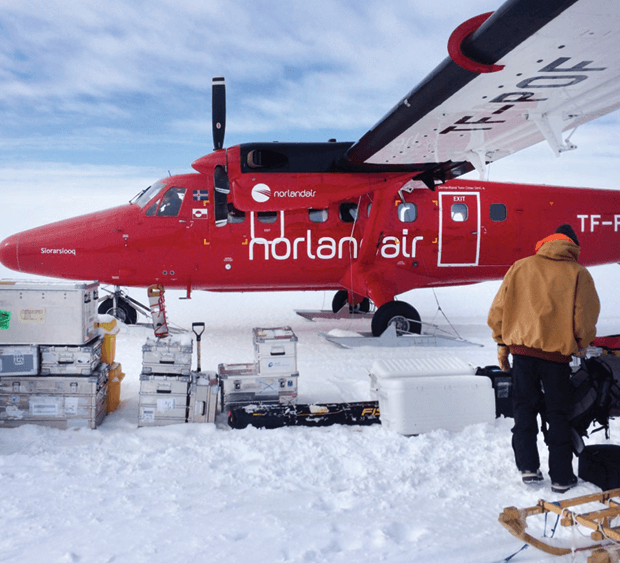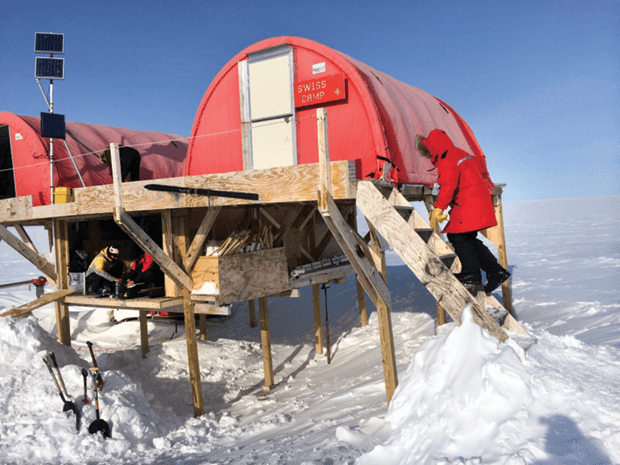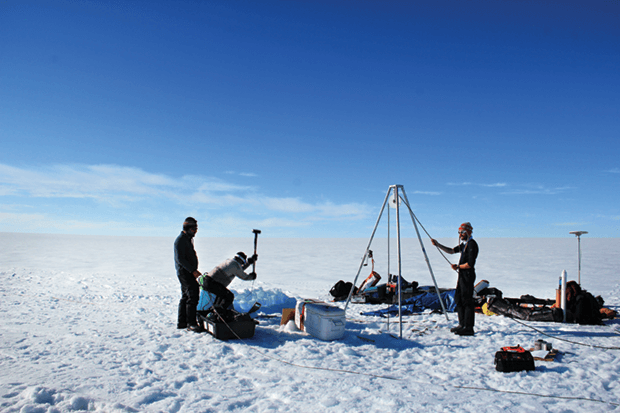- August 18, 2016
- By Chris Carroll
Lynn Montgomery ’16 had never even gone camping before last year, when she caught a helicopter to a barren glacier in Greenland to study the effects of global warming, coping all the while with the possibility of prowling polar bears and 15-foot snowfalls.
“We’re out on the ice sheet about 18 days to finish everything we need to do,” the former atmospheric and oceanic sciences major says. “Doing that was a pretty big leap for me.”
 She was assisting Nicholas Schmerr, an assistant professor of geology studying Greenland’s “firn”—a thick layer of packed snow that coats ice sheets. The formation caught the attention of global climate watchers earlier this decade when Schmerr’s collaborators from several universities described new subsurface lakes known as “firn aquifers” in areas that large-scale melting hadn’t been seen before.
She was assisting Nicholas Schmerr, an assistant professor of geology studying Greenland’s “firn”—a thick layer of packed snow that coats ice sheets. The formation caught the attention of global climate watchers earlier this decade when Schmerr’s collaborators from several universities described new subsurface lakes known as “firn aquifers” in areas that large-scale melting hadn’t been seen before.
“The consensus is that climate change is probably 100 percent responsible,” he says.
Schmerr is using seismology to measure an aquifer’s shape. With Montgomery’s help, he extended strings of sensors across the ice, and then bashed a metal plate with a sledgehammer. The sensors picked up the vibrations and gave a partial view of what lies beneath, helping to answer some fundamental questions.
 “Does the water drain to the bed of the ice sheet, or is it finding another pathway through the ice that we’re not aware of, or is just being stored there—perhaps growing in volume each year?” says Schmerr, who returned to Greenland this summer for more experiments.
“Does the water drain to the bed of the ice sheet, or is it finding another pathway through the ice that we’re not aware of, or is just being stored there—perhaps growing in volume each year?” says Schmerr, who returned to Greenland this summer for more experiments.
Greenland’s ice is closely linked to climate and coastlines. While Schmerr says emptying the Greenland firn aquifer into the oceans would raise the global sea level by only a millimeter (at a time when it’s already rising 1.8 millimeters a year), the entire island’s ice, if melted, could boost it by 7 meters.

Though most scientists consider that highly unlikely anytime soon, a far more modest melt still could impact global climate if enough freshwater pours into the North Atlantic to affect ocean currents.
Montgomery, meanwhile, plans to continue as a graduate student at Colorado, where one of Schmerr’s colleagues on the Greenland study, Lora Koenig, is a researcher at the National Snow and Ice Data Center.
“It was one of the most fantastic experiences of my life,” she says. “I’m definitely hoping to go back to Greenland.”
Photos courtesy of Derrick Lampkin and Lynn Montgomery
Tags
Research
 Greenland loses mass mainly through large fast-flowing glaciers—or “ice streams”—that transport ice from the interior to the ocean.
Greenland loses mass mainly through large fast-flowing glaciers—or “ice streams”—that transport ice from the interior to the ocean.